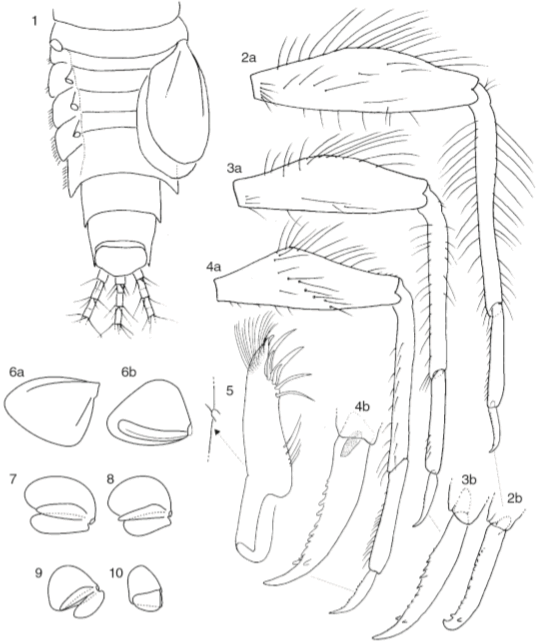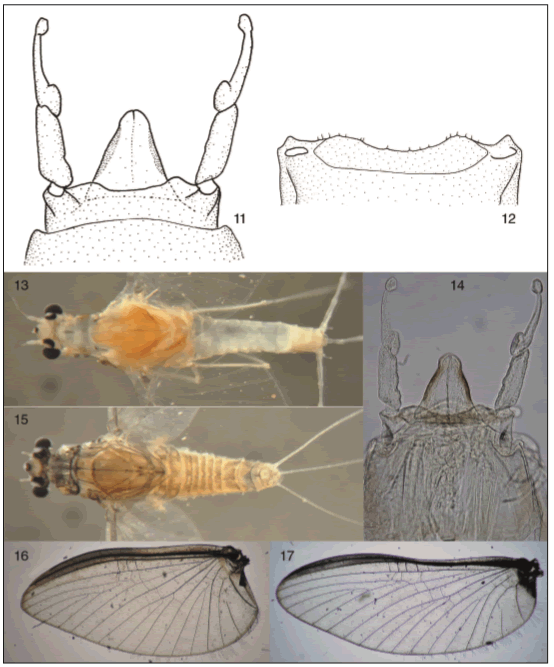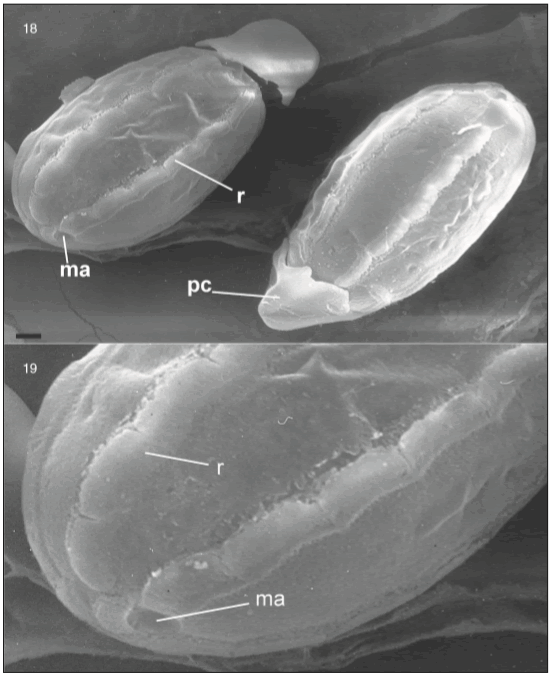Servicios Personalizados
Revista
Articulo
Indicadores
-
 Citado por SciELO
Citado por SciELO
Links relacionados
-
 Similares en
SciELO
Similares en
SciELO  uBio
uBio
Compartir
Revista de la Sociedad Entomológica Argentina
versión impresa ISSN 0373-5680
Rev. Soc. Entomol. Argent. vol.73 no.3-4 La Plata dic. 2014
TRABAJO CIENTÍFICO
Tricorythodes faeculopsis (Ephemeroptera: Leptohyphidae), description of new stages and first record from Venezuela
Tricorythodes faeculopsis (Ephemeroptera: Leptohyphidae), descripción de nuevos estadíos y primer registro de Venezuela
Molineri, Carlos1, Edmundo Guerrero2, 3 & María-Eugenia Grillet3
1 CONICET-Instituto de Biodiversidad Neotropical, Facultad de Ciencias Naturales, Universidad Nacional de Tucumán, M. Lillo 205, CP 4000, Tucumán, Argentina. E-mail: carlosmolineri@gmail.com
2 Museo del Instituto de Zoología Agrícola Francisco Fernández Yépez, Facultad de Agronomía, Universidad Central de Venezuela, Maracay, AP 4579, Maracay, Venezuela.
3 Laboratorio de Biología de Vectores y Parásitos, Instituto de Zoología y Ecología Tropical, Facultad de Ciencias, Universidad Central de Venezuela, Apartado 47058, Caracas 1041-A, Venezuela.
Recibido: 21-II-2014;
Aceptado: 01-VII-2014
RESUMEN. Tricorythodes faeculopsis Belmont, Salles & Hamada, es redescripto e ilustrado a partir de todos los estados. Se registra por primera vez esta especie de Venezuela. Los imagos macho y hembra y los huevos son descriptos por primera vez, y se brinda nueva información para las ninfas. Esta especie se caracteriza por presentar, en los adultos: longitud del ala anterior 2.9-3.6 mm; vena CuP ausente o reducida; forceps con segmentos I y II subiguales en longitud; penes piramidales, con márgenes amarillentos; ninfas: palpo maxilar pequeño, 1-segmentado; razón longitud / ancho máximo de los fémures ca. 0.3; uñas tarsales con 4-10 dentículos marginales y 1-2 submarginales; huevos con costillas longitudinales.
PALABRAS CLAVE: Pannota; Efímera; Neotrópico; Tricorythodes bullus.
ABSTRACT. Tricorythodes faeculopsis Belmont, Salles & Hamada, is redescribed and illustrated from all the stages. The species is firstly recorded from Venezuela. The male and female imago and eggs are here firstly described and new information is provided for nymphs. The species can be recognized by, adult: forewing length 2.9-3.6 mm; vein CuP absent or reduced; forceps segments I and II subequal in length; penes pyramidal, with yellowish margins; nymphs: maxillary palp small, 1-segmented; ratio length/maximum width of femora: ca. 0.3; tarsal claws with 4-10 marginal denticles and 1-2 submarginal denticles; eggs with longitudinal ridges.
KEY WORDS: Pannota; Mayfly; Neotropics; Trícorythodes bullus.
INTRODUCTION
Tricorythodes Ulmer is one of the twelve most specious genera of mayflies (Barber-James et al., 2008), with 51 species described from South, Central and North America. In spite of the adult stage (mainly male genitalia) being rather homogeneous throughout the genus, nymphs show a wide variety of body forms and associated heterogeneity in gills, mouthparts and legs. This differentiation in the immature stages led different authors to recognize numerous groups of species, sometimes formalized as subgenera or genera (Allen & Murvosh, 1987; Wiersema & McCafferty, 2000; Baumgardner & Avila, 2006): Asioplax Wiersema & McCafferty, Cabecar Baumgardner, Epiphrades Wiersema & McCafferty, Homoleptohyphes Allen & Murvosh and Tricoryhyphes Allen & Murvosh. Formal phylogenetic analyses failed to distinguish these taxa as monophyletic (Molineri, 2002; 2006) and until a comprehensive classification of the group can be attained through the phylogenetic analysis of all the species, we follow Molineri (2002) in treating all the species in Tricorythodes sensu lato.
The aim of the present paper is to describe the unknown stages (male and female imago and eggs) of a recently described species, T. faeculopsis Belmont, Salles & Hamada (2011), from new specimens (eggs, nymphs and adults of both sexes) collected in the Guayana's Uplands of Venezuela.
MATERIALS AND METHODS
Dissected parts of the nymphs and adults were mounted on microscope sudes using Canadá Balsam, except wings that were mounted dried. All the material is preserved in ethyl alcohol 96%. Photographs were taken using a NIKON SMZ-10 stereomlcroscope or a microscope, with a Nikon D5000 digital camera; and ine drawings were done using a camera lucida attached to a microscope.
Nymphs and adults were associated by shared color pattern of a pharate male subimago inside the nymphal cuticle; and a témale mature nymph with the same coloration of adult female. Eggs used for SEM study were dehydrated in a graded ethanol series, dried by the critical point method, sputter coated with gold and observed with a JEOL 35 CF scanning electrón microscope (more details of this process are given in Molineri, 2004).
Collectors are abbreviated as follows: EG (Edmundo Guerrero), Ana-María Oliveira Pes (AMO), María-Eugenia Grillet (MEG), and Carlos Augusto da Silva Azevędo (CA). Material deposition: MLBV, the Invertebrate Collection of Laboratorio de Biología de Vectores (Instituto de Zoología y Ecología Tropical, Universidad Central de Venezuela, Caracas) and IBN (Instituto de Biodiversidad Neotropical, Tucumán, Argentina).
RESULTS
Tricorythodes faeculopsis Belmont, Salles & Hamada (2011)
Material examined. Venezuela. Two nymphs from, Bolívar State, the Kauí stream, N 05° 28' 34", W 61° 16' 20", 1196 m, 24-XI-2005, EG and MEG cols. (IBN); 1 male and 6 female imagos from the Mareman-Parú river, N 05° 44' 49", W 61° 24' 6", 1308 m, 26-VI-2007, EG , AMO, CA and MEG cols. (MLVB); 7 male imagos same data except date 28-VI-2007 (MLVB); 7 female imagos from the Kaku-Parú stream, N 4° 54' 0", W 61° 5' 25", 913 m, 29-VI-2007, EG , AMO, CA and MEG cols. (IBN); 20 male imagos same data except date 28-VI-2007 (IBN); 6 male imagos from the Tarotá stream, N 05° 49' 15", W 61° 25' 4", 1324 m, 27-VI-2007, EG, AMO, CA and MEG cols. (MLVB).
Diagnosis. Nymphs: maxillary palp small 1-segmented with apical seta, galea-lacinia twice the length of the stipes (Fig. 5); ratio length/ maximum width of femora: 0.28-0.33 (Figs. 2a, 3a, 4a); transversal row of long setae on dorsum of forefemora located at 0.35 from base (Fig. 4a); tarsal claws with 4-10 marginal denticles and 1-2 submarginal denticles in a double row (Figs. 2b, 3b, 4b); operculate gills subtriangular and translucent, only with a gray minute mark on base (Figs. 6a-b); legs pale; lateral flanges on abdominal segments 3-7, and posterolateral spines on segments 7-9 (Fig. 1). Imago: small species (forewings 2.9-3.6 mm), with whitish males almost without gray markings, females with gray marks distally on all femora and on abdominal terga (Figs. 13, 15); compound eyes are small, holoptic and well separated in dorsum of head in both sexes (Figs. 13, 15); vein CuP absent or partially present (only basal 1/3) (Figs. 16-17); the ratio length of forceps segment I/forceps segment II is 1.0 (Figs. 11, 14); penes pyramidal, with a small apical furrow 0.1 the length of penes, and with sclerotized yellowish lateral margins (Figs. 11, 14); styliger plate projected sublaterally and with tiny spines on hind margin (Fig. 12). Eggs: adhesive filaments absent (Figs. 18-19); chorionic plates aligned longitudinally forming 6 ridges (Figs. 18-19); micropylar area located near the uncapped pole (Figs. 18-19).
Mature nymph (Figs. 1-10). Length of male (mm): body, 3.1; cerci, 1.75; terminal filament, 2.2. Length of female (mm): body, 3.75; hind femur, 0.85; cerci and terminal filament, 2.0. Male nymph (ready to molt to subimago) whitish, very pale, shaded very slightly with gray on abdominal sterna I-II. Female nymph (nearly mature) yellowish white with gray markings described below. Head. Occiput with a net-shaped gray pattern, darker on a transversal line between lateral ocelli, a gray medial line extending to hind margin and a blackish thin line along hind margin. Mouthparts: typical for the genus, maxillary palp small, 1-segmented with apical seta (Fig. 5), distal brush of maxilla with about 20 long and curved setae, with stipes 0.5 the length of galea-lacinia, inner proximal margin of the galea-lacinia with 5 setae (Fig. 5); labium with paraglossae and glossae with the same length. Thorax. Mesonotum with small gray marks anterolaterally, wingbuds with developing costal veins grayish. Legs (Figs. 2-4): foreleg (Fig. 4a): proximal portion of transverse row of long setae at 0.35 of total femoral length from base; maximum width of femur 0.33 of total length, tarsal claw with 10 marginal denticles increasing in size distally (the last one is subparallel to the margin) and with 2 sumbarginal denticles contiguously to this marginal row (Fig. 4b). Middle leg (Fig. 3a): femur maximum width 0.30 of total length, with long setae along entire hind margin and basal half of fore margin; tarsal claw with 9 marginal denticles increasing in size distally until the fifth denticle, then decreasing in size, subdistally with 1 submarginal denticle (Fig. 3b). Hind leg (Fig. 2a): femur maximum width 0.28 of total length, with long setae along entire hind and fore margins and along a medial scattered row dorsally; tarsal claw with 10 marginal denticles increasing in size distally and with a pair of submarginal subapical denticles (Fig. 2b). Abdomen (Fig. 1). Posterolateral spines present on segments VII-IX (smaller in male), lateral flanges present on segments III-VII. Operculate gills subtriangular (Figs. 6a-b), whitish translucent, shaded gray on a small basal mark, with a single ventral lamella. Gill formula 2/3/3/3/2 (Figs. 6-10). Caudal filaments whitish translucent (slightly shaded gray on male).

Figs. 1-10. Tricorythodes faeculopsis Belmont, Salles & Hamada, nymph. 1, abdomen, dorsal view (dv), without left gills; 2a-b, hind leg and detail of claw; 3a-b, middle leg and detail of claw; 4a-b, foreleg and detail of claw; 5, maxillae and detail of palpus; 6a-b, operculate gill II, dorsal and ventral view respectively; 7-10, gills III to VI, ventral view (vv).
Male imago (Figs. 11-12, 13-14, 16). Length (mm): body, 2.9-3.3; forewing, 2.9-3.2; cerci, 7.0-7.5; terminal filament, 11.1-12.2. General coloration whitish translucent. Head (Fig. 13). Whitish with a thin V-shaped brownish mark between lateral ocelli, behind and superimposed to this mark a light gray shading is present, ventrally with small grayish marks on the zones previously occupied by mandibles and labium. Thorax (Fig. 13). Pronotum translucent except for yellowish marks laterally and a grayish elongated mark anteromedially. Meso- and metathorax with yellowish sclerites, membranes lighter. Legs: femora yellowish white, rest of legs whitish translucent, a subdistal gray mark is present on forefemora. Wings (Fig. 16): membrane hyaline, veins translucent except C, Sc and R1 slightly shaded gray basally. Abdomen (Fig. 13). Hyaline translucent except segments IX-X whitish, shaded slightly with gray on sternum I. Genitalia (Figs. 11-12, 14): whitish translucent except hind margin of styliger and lateral margins of penes yellowish; the yellowish portion of the styliger is concave medially and roundly projected sublaterally and presents an irregular hind margin with minute spines (Fig. 12); the whitish portion of the styliger forms a ventrally protruding base for each forceps; the styliger also presents small projections dorsally to forceps base (Fig. 12); forceps segment I equal in length to segment II. Penes pyramidal completely fused except for a small apical furrow 0.1 the length of penes. Caudal filaments translucent.
Female imago (Figs. 15, 17). Length (mm): body, 3.1-3.2; forewing, 3.3-3.6; cerci, 1.5; terminal filament, 2.0. General coloration yellowish (Fig. 15). Head. Similar to male but V-shaped mark wider and gray shading stronger (Fig. 15). Thorax (Fig. 15). Pronotum translucent, almost completely shaded with gray except on a pair of submedian elongated pale spots near hind margin. Mesothorax brownish yellow shaded widely with gray except, carinae and margins black; rest of thorax yellowish. Legs: all femora whitish with a gray subapical mark and a lighter grayish elongated mark near base; tibiae and tarsi translucent shaded with gray medially on hind tibiae, a small light gray spot is present basally to all tarsal claws. Wings (Fig. 17): membrane hyaline, longitudinal veins grayish, somewhat purplish at base of C, Sc and R1; membranous filaments of mesoscutellum grayish. Abdomen. Yellowish white shaded with gray dorsally on extensive pattern (Fig. 15). Ninth sternum roundly projected. Caudal filaments whitish.

Figs. 11-17. Tricorythodes faeculopsis Belmont, Salles & Hamada. Imagos. Male genitalia: 11, general, vv; 12, detail of styliger, vv.; 13, male, dv; 14, male genitalia, vv; 15, female, dv; 16, male forewing; 17, female forewing.
Eggs (Figs. 18-19). Length: 130 µ. Maximum width: 65 µ. One polar cap present. Circular micropylar area located near the uncapped pole. Chorionic plates aligned in groups (of 6-7 plates) forming 6 longitudinal ridges extending from pole to pole. The surface between the ridges is occupied by smooth chorion. Adhesive filaments absent.

Figs. 18-19. Tricorythodes faeculopsis Belmont, Salles & Hamada. Eggs. 18, general view; 19, detail of uncapped pole. Abbreviations: ma= micropylar area, pc= polar cap, r= ridge. (Scale bar= 10µ.)
Ecology. Imagos were collected along the stream margins, at night, and during the rainy season (November 2005 and June 2007), by using light traps; whereas, nymphs were collected within the rivers using a D-net. Rivers flow through an upland savanna ecosystem, and they were partially shaded (Kaku-Parú, Kaui) or unshaded (Mareman-Parú and Tarotá), small to medium size, shallow bedrock bottom (18-30 m wide; 1st -3rd order), rivers with acidic waters (pH=5).
DISCUSSION
The genus Tricorythodes s.l. (including Asioplax, Cabecar, Epiphrades, Homoleptohyphes and Tricoryhyphes) ranges from Canada to Central Argentina and is presently composed by 51 species. Tricorythodes faeculopsis shows a unique combination of characters useful to distinguish the alate, nymphal and egg stages from all the species in Tricorythodes sensu lato (see diagnosis above). The same list of characters, together with the swelling at base of second forceps segment (a unique characteristic of Tricorythodes s.l.), is useful to separate this species from other taxa of the Leptohyphidae (including Macunahyphes).
The penes of T. faeculopsis are similar to T. bullus and T. chalaza, in the pyramidal form and in the almost complete fusion of the lobes. Also these three species show a reduced vein CuP in the forewings, sometimes absent or partially developed, with different states even in the wings of the same specimen. Nevertheless, the adults of T. faeculopsis can be distinguished for their smaller size and much paler coloration on the body and wings.
In the nymphal stage, T. faeculopsis is similar to T. cristatus Allen (1967), T. bullus Allen (1967) and T . chalaza Gonçalves et al. (2010) in leg setation and form of femora, but the new species can be differentiated by the absence of dorsal tubercles on the head and/or thorax. Belmont et al. (2011) reported only 4 to 6 marginal denticles on tarsal claws, so here we are extending the range to 10 denticles. These authors also mentioned that abdominal gill on segment VI is formed by a unique lamella, but our specimens show two lamellae (one of them is hard to distinguish because of its small size).
The eggs of T. faeculopsis are remarkable in the mode that the chorionic plates are aligned forming longitudinal ridges. The eggs of other species of Tricorythodes s.l. are very scarcely known (e.g., T. hiemalis Molineri, 2001; T. griseus Hofmann et al., 1999) but their chorionic plates are more homogeneously distributed on the egg surface. This characteristic is common in the family Leptohyphidae (Macunahyphes Dias et al., 2005; Traverhyphes, Leptohyphes, and Haplohyphes, Molineri, 2004; 2006) and the ridges shown in T. faeculopsis are probably the derived state that should be explored in related species. The absence of adhesive filaments is shared with Macunahyphes australis.
ACKNOWLEDGEMENTS
We thank Ana María Oliveira Pes, Neusa Hamada, Carlos Augusto da Silva Azevedo, Nelson Moncada, and Fabiola Del Ventura who assisted us in the field. Material and photographs from SEM were prepared at Centro Integral de Microscopía Electrónica (CIME), CONICET, Tucumán, Argentina. This work was partially financed by the Council for Sciences and Humanities Development (CDCH-UCV, PG 03-00-5739) from Venezuela, and National Council of Scientific Research from Argentina (CONICET, PIP 0330).
LITERATURE CITED
1. ALLEN, R. K. 1967. New species of New World Lepto-hyphinae (Ephemeroptera: Tricorythidae). The Canadian Entomologist 99: 350-375. [ Links ]
2. ALLEN, R. K. & C. M. MURVOSH. 1987. Mayflies (Ephemeroptera: Tricorythidae) of the southwestern United States and northern Mexico. Annals of the Entomological Society of America 80: 35-40. [ Links ]
3. BARBER-JAMES, H. M., J. L. GATTOLLIAT, M. SARTORI & M. D. HUBBARD. 2008. Global diversity of mayflies (Ephemeroptera, Insecta) in freshwater. Hydrobiologia 595: 339-350. [ Links ]
4. BAUMGARDNER, D. E. & A. S. ÁVILA. 2006. Cabecar serratus, a new genus and species of leptohyphid mayfly from Central America, and description of the imaginal stages of Tricorythodes sordidus Allen (Ephemeroptera: Lepto-hyphidae). Zootaxa 1187: 47-59. [ Links ]
5. BELMONT, E. L. L., F. F. SALLES & N. HAMADA. 2011. Three new species of Leptohyphidae (Insecta: Ephemeroptera) from Central Amazon, Brazil. Zootaxa 3047: 43-53. [ Links ]
6. DIAS, L. G., F. F. SALLES & C. MOLINERI. 2005. Macuna-hyphes: A new genus for Tricorythodes australis (Ephemeroptera: Lepto-hyphidae). Annals de Limnologie 41: 195-201. [ Links ]
7. GONÇALVES, I. C., E. R. DA-SILVA & J. L. NESSIMIAN. 2010. Two new species of Tricorythodes Ulmer, 1920 (Insecta, Ephemeroptera) from Southeastern Brazil. Zootaxa 2721: 62-68. [ Links ]
8. HOFMANN, C., M. SARTORI & A. THOMAS. 1999. Les Ephéméroptères (Ephemeroptera) de la Guadeloupe (petites Antilles françaises). Mémoires de la Société Vaudoise des Sciences Naturelles 20 (1): 1-95. [ Links ]
9. MOLINERI, C. 2001. Una especie nueva de Tricorythodes (Ephemeroptera: Lepto-hyphidae) de la Argentina con notas sobre su biología. Revista de la Sociedad Argentina de Entomología 60 (1-4): 61-66. [ Links ]
10. MOLINERI, C. 2002. Cladistic analysis of the South American species of Tricorythodes (Ephemeroptera: Leptohyphidae) with the description of new species and stages. Aquatic Insects 24: 273-308. [ Links ]
11. MOLINERI, C. 2004. Phylogeny of the Allenhyphes-Traver-hyphes group (Ephemeroptera: Leptohyphidae), with new subgenera, species and combinations. Tijdschrift voor Entomologie 147: 197-220. [ Links ]
12. MOLINERI, C. 2006. Phylogeny of the mayfly family Lepto-hyphidae (Insecta: Ephemeroptera) in South America. Systematic Entomology 31: 1-18. [ Links ]
13. WIERSEMA, N. A. & W. P. MCCAFFERTY. 2000. Generic Revision of the North and Central American Leptohyphidae (Ephemeroptera: Pannota). Transactions of the American Entomological Society 126: 337-371. [ Links ]














